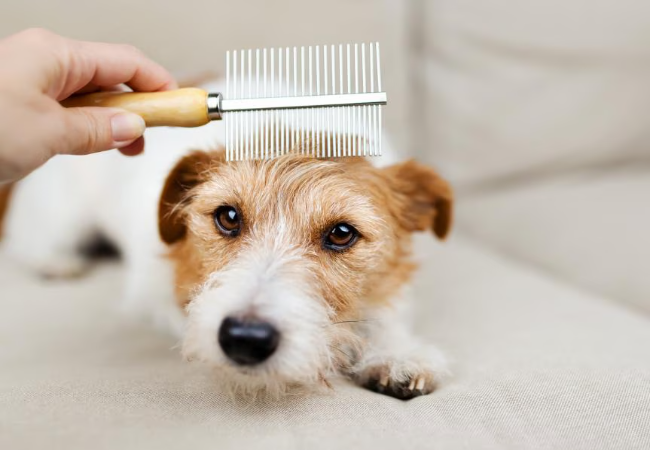Handle Fleas on Dogs 2025: Vet Approved Removal & Prevention 🐶🛡️

In this article
Handle Fleas on Dogs 2025: Vet Approved Removal & Prevention 🐶🛡️
By Dr. Duncan Houston BVSc
📌 Why Flea Control Is Essential
Fleas aren’t just itchy nuisances—they transmit diseases like tapeworms, Bartonella, and plague, and can cause anemia or flea allergy dermatitis (FAD) in sensitive dogs.
Plus, they infest your home quickly—egg-to-adult cycle can take as little as 2–3 weeks, and pupae may lurk for months.
🔍 Spotting a Flea Infestation
- Frequent scratching, especially around the tail, neck, and belly
- Visible fleas or "flea dirt" (tiny black specks that turn red when wet)
- Hair loss, redness, scabbing, or irritated skin
- Pale gums or lethargy—signs of heavy infestation or anemia
✅ Step 1: Veterinary-Recommended Flea Medications
Choose a vet-approved preventive—oral chews, topicals, collars—focusing on adulticide + IGR to interrupt the life cycle.
- Oral pills: Monthly or quarterly (e.g., Capstar®/Nitenpyram for fast kill within 30 mins; Credelio Quattro for broad coverage).
- Topical spot-ons: Monthly; avoid over-bathing and protect other pets/children until dry.
- Flea collars: Long-lasting; choose vet-approved types—some have safety concerns.
- Shampoos: Flea shampoos with adulticides offer short-term relief.
✅ Step 2: Flea Combing & Baths
- Use a fine-toothed flea comb daily—focus on neck and base of tail; dip comb into soapy water to drown fleas.
- Bathe with gentle flea shampoo (aloe or oatmeal-based) to kill adults and soothe skin—but note this doesn’t prevent reinfestation.
🏠 Step 3: Home & Yard Treatment
Adult fleas are just ~5% of the infestation—targeting the environment is critical.
- Vacuum floors, carpets, and under furniture daily; promptly discard vacuum bags.
- Wash bedding in hot water weekly.
- Use IGR-containing sprays or foggers in the home and yard to disrupt egg/larvae cycles.
- Trim grass/outdoor areas to reduce flea habitat.
🌱 Step 4: Eco-Friendly Flea Management
Topical treatments can pollute waterways—opt for oral or injectable alternatives and safe cleaning practices.
- Brush pets indoors and discard fur properly.
- Seal and dispose of applicator packaging.
- Avoid wild animal exposure by securing trash and avoiding stagnant water.
⚠️ Addressing Flea Allergy Dermatitis (FAD)
Even one flea bite can trigger FAD—symptoms include intense itching, hot spots, hair loss.
- Prompt flea removal and environmental control.
- Veterinary skin treatment, steroids, or antibiotics as needed.
- Continued prevention even after symptoms clear.
📅 How Long Does Treatment Take?
Expect full flea elimination to take 3 months due to life cycle resilience. Continue prevention year-round—even in winter—since infestations are possible anytime.
🧠 Dr Houston’s Flea Control Checklist
- ✅ Fast-acting oral dose (e.g., Capstar®) for immediate relief
- ✅ Monthly vet-recommended preventatives with adulticide+IGR
- ✅ Daily flea combing and weekly baths
- ✅ Thorough vacuuming, washing, and environmental spray
- ✅ Eco-smart disposal of fur, packaging, and cleaning runoff
- ✅ Year-round prevention, especially in warm climates
- 📱 Ask A Vet available for treatment questions and product choice
📌 When to Call Your Vet:
- Persistent scratching or skin infections
- Signs of anemia or discomfort
- No improvement after 1–2 weeks
- Puppies, seniors, or dogs with health conditions
🌟 Final Thoughts
Handling fleas well means combining safe treatments for your dog and releasing your home from flea reservoirs. With proper medications, regular combing, bathing, and home cleaning, most infestations clear within 3 months. Stay proactive—and lean on Ask A Vet anytime you need guidance. 🐾❤️
Need help choosing products or managing itchy skin? Visit AskAVet.com or download the Ask A Vet app—your trusted advisor for flea control. 📱🐶






